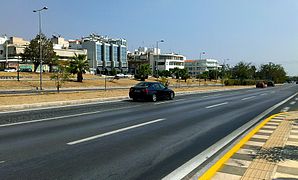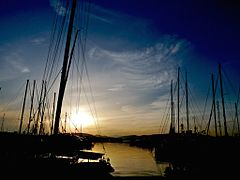Alimos
|
Alimos community Δήμος Αλίμου (Άλιμος) |
||
|---|---|---|
|
|
||
| Basic data | ||
| State : |
|
|
| Region : | Attica | |
| Regional District : | Athens South | |
| Geographic coordinates : | 37 ° 54 ' N , 23 ° 44' E | |
| Area : | 5.909 km² | |
| Residents : | 41,720 (2011) | |
| Population density : | 7,060.4 inhabitants / km² | |
| Post Code: | 174xx | |
| Prefix: | (+30) 210 | |
| Community logo: | ||
| Seat: | Kalamaki | |
| LAU-1 code no .: | 4803 | |
| Districts : | no | |
| Local self-government : |
no |
|
| Website: | www.alimos.gov.gr | |
| Location in the Attica region | ||
Alimos ( Greek Άλιμος ( m. Sg. ), Also Kalamaki Καλαμάκι ( n. Sg. )) Is a municipality and a southern suburb of the Greek capital Athens on the coast of the Saronic Gulf , a few kilometers southwest of the Ymittos .
geography
Alimos is around eight kilometers south of central Athens. In Kalamaki proper, it has an approximately 2.5 km long stretch of coast on the Saronic Gulf between the mouth of the Pikrodafni stream in the north and the rocky cape of Agios Kosmas in the south. To the north, the municipality borders on Paleo Faliro , to the southern neighboring municipality is Elliniko-Argyroupoli , where the site of the former Athens-Elliniko airport or today the Elliniko Olympic Complex is directly connected. The community extends around three kilometers east inland to the Trachones district and here extends to Vouliagmeni Boulevard, where the urban area merges into Ilioupoli . The northern neighboring municipality towards the center of Athens is Agios Dimitrios .
Alimos' terrain is flat and only gradually rises to the east. The only elevation is the small Pani hill (gr. Lofos Pani λόφος Πανί, after Pan ), which reaches almost 100 meters in height. At the top there was a large gun emplacement to defend the old Athens airport during World War II, remains of which can still be seen.
Neighborhoods are Ambelakia, Anapiron, Kalamaki, Ano Kalamaki, Ekteloniston, Eforiakon, Kefallinon, Kythirion (Tsirigotika), Lofos Pani and Trachones in the Vouliagmeni Boulevard area.
Alimos is one of the comparatively expensive communities in Attica. The real estate prices in 2007 were between € 1500 and € 2850 per square meter. Its prime location by the sea and its respected name make it a favorite summer retreat for Athenians.
history
There is evidence that the area of Alimos was already settled in the Neolithic . The finds in a Bronze Age settlement from around 2300 BC BC allow the conclusion that the settlers came from the Cyclades and worked and traded obsidian from Milos here . This settlement grew up on the ancient Cape Kolias (today's Agios Kosmas) to a fishing and farming village, which cultivated the area up to today's eastern border of the municipality, where later the territory of the Demos Euonymon began. This settlement was founded around 2000 BC. Chr. Destroyed. It was not until around six centuries later that a second settlement of the Mycenaean culture , which lived from fishing and exploiting purple snails , was possibly fortified by a defensive wall at Cape Kolias and was built in 1100 BC. Chr. Went down again.

Around 800 BC The place was settled again. The name Kolias is found in sources from historical times as the location of a temple of the Coliad Aphrodite as the patron saint of pregnant women, who was one of the important shrines of Attica. Up to classical antiquity, the Demos Halimus ( ancient Greek Ἁλιμοῦς ) developed north of the cape , a fishing village that derived its name from the name of a type of seaweed or samphire ( halima ἅλιμα , this to halimos ἅλιμος , 'belonging to the sea'). Halimus belonged to the Attic phyle Leontis . In the middle of the modern community inland are the remains of a small theater with a square orchestra . Ancient Halimus has been handed down as the birthplace of Thucydides , whose portrait is also featured on the modern community logo. Ancient Halimus fell into disrepair in Roman times.
Evidence from Byzantine times is scarce. In 1929 the remains of a church from the 6th century were found on the small Pani hill, suggesting a settlement. Probably in the 10th century the settlement of Trachones arose in a rocky, less fertile terrain as a poor farming village (Greek trachys τραχύς means 'rough'). The Marienkirche der Lebensgendenden Quelle, in the forecourt of which remains from the 6th century were also found, but which itself dates back to the 11th century, gives hints of rulers from Asia Minor, which Emperor Basil II is said to have installed in Attica.
During the Ottoman period, the area south of Athens belonged to a few large landowners, whose names have been handed down as Brachami and Chasani and are reflected in the place names Brachami (since 1928 Agios Dimitrios) and Chasani (from 1920 Komnina, 1942 to Elliniko). After the founding of modern Greece in 1830, the large estates were parceled out and passed to different owners, including former fighters of the Greek Revolution , which resulted in small settlements again. The politician and author Ioannis Makrygiannis also bought a piece of land a few kilometers northeast of Agios Kosmas; in the corresponding sales contract, the place is mentioned for the first time as Kalamakia in Athens (Καλαμάκια των Αθηνών). The eastern part around Trachones was long owned by the Greek Ministry of the Navy. Marinos Geroulanos bought the land at auction .
At first around a hundred families lived in Kalamaki along the coast. The place gradually expanded at the beginning of the 20th century, mainly as a holiday resort for wealthy Athenians. It became independent as the rural municipality of Kalamaki (Κοινότητα Καλαμακίου) in 1927 and spun off from the municipality of Brachami (today Agios Dimitrios). In 1928 the engineer Andonios Pizanis made the first draft for the development of the community. In 1942 Kalamaki came to Paleo Faliro , which became a municipality, but in 1945 it became independent again.
In 1968, during the Junta era , Elliniko and Kalamaki were united into a township called Alimos. Elliniko - and with it the area of ancient Alimus - was able to become independent again in 1975 in view of the rapidly increasing population. Since that time, Kalamaki has remained unchanged as Alimos; it was not affected by the two municipal reforms in 1997 and 2010.
Attractions
On the territory of the municipality, near the marina, is the Paleo Faliro military cemetery from the Second World War with over 2000 graves of British, Canadian, New Zealand, Australian and South African fallen soldiers as well as the ashes of 74 Indian soldiers who died in Greece. He is maintained by the Commonwealth War Graves Commission .
Economy and Infrastructure
In Alimos, tourism is particularly important due to the sandy beach and the marina. The Alimos marina is the largest Greek marina with berths for around 1000 boats, including 50 places for boats over 25 meters in length. A service area of over 170,000 square meters of land is connected. The city's swimming pool is also located directly at the marina.
Numerous sports clubs operate in Alimos.
The Athens tram coastline has been running through Alimos since 2004 . Line 2 of the Athens Metro was extended to Elliniko in 2013 and runs past the eastern edge of the municipality.
Personalities
The Greek Prime Minister Konstantinos Logothetopoulos (1878–1961) lived in Kalamaki. As secretary of a landowners association, he helped found the Kalamaki community in 1927 and died in the community.
Individual evidence
- ↑ Results of the 2011 census at the Greek Statistical Office ELSTAT ( Memento of November 13, 2011 in the Internet Archive )
- ↑ Prices per m² for the Athens Metropolitan Area for 2007 by the Ministry of Economy . (No longer available online.) Formerly in the original ; accessed on May 22, 2020 . ( Page no longer available , search in web archives )
- ^ William Smith: Dictionary of Greek and Roman Geography, London 1854 ( entry on Attika online )
- ↑ a b Renaming and administrative history of the database of the EETAA (Greek Society for Development and Decentralization) ( Memento of October 16, 2013 in the Internet Archive )
- ↑ a b Dimitris Karanikolas: Article on the history of Alimos ( Memento from May 22, 2014 in the Internet Archive )








